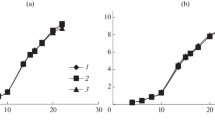Abstract
A comparative study was performed of the processes of autolytic degradation of the cells of Saccharomyces cerevisiae and Schizosaccharomyces pombe under conditions simulating the phase of cell death in microbial cultures: (1) during autolysis induced by oleic acid, which is the chemical analogue of factors d2 (autolysis autoinducer), (2) under the effect of extracellular microbial proteinases (enzymatic lysis), and (3) under the concomitant effect of the enzymes of the endogenous autolytic complex and exogenous proteinases (heterolysis). Regulatory mechanisms controlling the rate and profundity of autolysis were elucidated, relying on the stabilization of hydrolytic enzymes and enhancement of their activity in their complexes with a chemical analogue of microbial autoregulatory factors d1, which belong to alkylhydroxybenzenes and fulfill functions of chemical chaperones. The changes in the activity of proteinases and enzymes of the autolytic complex were shown to be dependent on the concentration of the analogue at the moment of complex formation.
Similar content being viewed by others
REFERENCES
Sudo, S.Z. and Dworkin, M., Comparative Biology of Prokaryotic Resting Cells, Adv. Microb. Physiol., 1973, vol. 9, pp. 153–224.
Mulyukin, A.L., Lusta, K.A., Gryaznova, M.N., Babusenko, E.S., Kozlova, A.N., Duzha, M.V., Mityushina, L.A., Duda, V.I., and El'-Registan, G.I., Formation of Resting Cells in Microbial Suspensions Undergoing Autolysis, Mikrobiologiya, 1997, vol. 66, no. 1, pp. 42–49.
Rosenbluh, A. and Rosenberg, E., Role of Autocide AMI in Development of Myxococcus xanthus, J. Bacteriol., 1990, vol. 172, pp. 4307–4314.
Neklyudov, A.D., Ivankin, A.N., and Berdutina, A.V., Hydrolysates: Properties and Applications (A Review), Prikl. Biokhim. Mikrobiol., 2000, vol. 36, no. 5, pp. 525–534.
Ivanova, N.G., Induced Autolysis of Yeast, Cand. Sci. (Biol.) Dissertation, Moscow, 1998.
Svetlichnyi, V.A., El'-Registan, G.I., Romanova, A.K., and Duda, V.I., Characterization of the Autoregulatory Factor d2 Inducting Autolysis of Pseudomonas carboxydoflava and Bacillus cereus Cells, Mikrobiologiya, 1983, vol. 52, pp. 33–38.
Konovalova, E.Yu., El'-Registan, G.I., and Bab'eva, I.P., Accumulation of the Autoregulatory factors d1 and d2 by the Yeast Rhodosporidium toruloides, Biotekhnologiya, 1985, no. 3, pp. 71–74.
Ivanova, N.G., El'-Registan, G.I., Kozlova, A.N., and Krylov, I.A, Methods for Obtaining Biologically Active Compounds, RF Patent no. 2136172, Sept. 10, 1999.
Bravova, G.B., Ivanova, N.G., El'-Registan, G.I., Kozlova, A.N., Bakanova, N.V., and Konobrii, V.N., Induced Autolysis and Its Application for Enhancement of the Efficiency of Microbial Biomass Utilization, Obzornaya informatsiya, Moscow, 1990, no. 4, p. 30.
Osipov, G.A., El'-Registan, G.I., Svetlichnyi, V.A., Kozlova, A.N., Duda, V.I., Kaprel'yants, A.S., and Pomazanov, V.V., On the Chemical Nature of the Autoregulatory Factor d of Pseudomonas carboxydoflava, Mikrobiologiya, 1985, vol. 54, no. 2, pp. 184–190.
Batrakov, S.G., El'-Registan, G.I., Pridachina, N.N., Nenasheva, V.A., Kozlova, A.N., Gryaznova, M.N., and Zolotareva, I.N., Tirosol is the Autoregulatory Factor d1 of Saccharomyces cerevisiae, Mikrobiologiya, 1993, vol. 62, no. 4, pp. 633–638.
Mulyukin, A.L., Kozlova, A.N., Kaprel'yants, A.S., and El'-Registan, G.I., The d1 Autoregulatory Factor in Micrococcus luteus Cells and Culture Liquid: Detection and Accumulation Dynamics, Mikrobiologiya, 1996, vol. 65, no. 1, pp. 20–25.
Bespalov, M.M., Kolpakov, A.I., Loiko, N.G., Doroshenko, E.V., Mulyukin, A.L., Kozlova, A.N., Varlamova, E.A., Kurganov, B.I., and El'-Registan, G.I., The Role of Microbial Dormancy Autoinducers in Metabolism Blockade, Mikrobiologiya, 2000, vol. 69, no. 2, pp.-217–223.
Kolpakov, A.I., Il'inskaya, O.N., Bespalov, M.M., Kupriyanova-Ashina, F.G., Gal'chenko, V.F., Kurganov, B.I., and El'-Registan, G.I., Stabilization of Enzymes by Dormancy Autoinducers as a Possible Mechanism of Resistance of Resting Microbial Forms, Mikrobiologiya, 2000, vol. 69, no. 2, pp. 224–230.
Lowry, O.H., Rosenbrough, N.J., Farr, A.L., and Randall, R.J., Protein Measurement with the Folin Phenol Reagent, J. Biol. Chem., 1951, vol. 193, pp. 265–267.
Fields, R., The Measurement of Amino Groups in Proteins and Peptides, Biochem. J., 1971, vol. 124, pp. 581–590.
Spirin, A.E., Spectrophotometric Determination of the Total Amount of Nucleic Acids, Biokhimiya, 1958, vol.23, no. 5, p. 656.
El'-Registan, G.I. and Babayan, T.L., Yavlenie avtoliza u mikroorganizmov (The Phenomenon of Autolysis in Microorganisms), Moscow: TsBNTI Minmedbioproma, 1987, no. 2.
Loiko, N.G., Kozlova, A.N., Osipov, G.A., and El'-Registan, G.I., Low-Molecular-Weight Autoregulatory Factors of the Haloalkaliphilic Bakterii Thioalkalivibrio versutus and Thioalkalimicrobium aerophilum, Mikrobiologiya, 2002, vol. 71, no. 3, pp. 308–315.
Author information
Authors and Affiliations
Rights and permissions
About this article
Cite this article
Karpekina, T.A., Stepanenko, I.Y., Krylova, E.I. et al. Involvement of Microbial Alkyl Hydroxybenzenes in the Regulation of Autolytic Degradation of Yeast Cells. Microbiology 71, 525–531 (2002). https://doi.org/10.1023/A:1020598401075
Issue Date:
DOI: https://doi.org/10.1023/A:1020598401075




